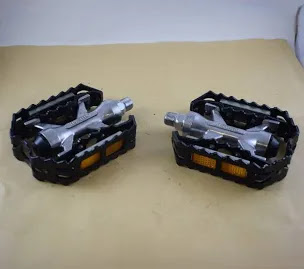No, I'm not assuming that you are, or have ever been, an exterminator. Instead, I am talking about a type of bicycle component and a style of a certain bike accessory.
Rattraps, of course, are what are commonly called "cage" pedals. On such pedals, the metal (aluminum or steel) plates have serrated edges on both sides, the better to grip the sole of your shoe. (I actually rode a pair barefoot. I think I can still see the marks.) Those cages usually don't have the "quill" common on traditional-style racing pedals. And, because the cages have the same serrated surfaces on both sides, they can be ridden with or without toeclips.
Examples of "rattrap" pedals include the MKS Sylvan and the Lyotard 460D:
 |
| MKS Sylvan |
 |
| Lyotard 460D. They were usually silver, but for a time were also available in blue, red or black. |
Many different companies make, and have made versions of the "mousetrap". Some claim to be better versions of the most famous (if not original) one: The Pletscher Model C.
I bought one for $2.75, new, at Michaels's Bicycle Co. on Route 35 in Hazlet, NJ. That rack ended up on about three or four bikes I owned during my youth. It was actually good for a light load, but would sway a lot when used with panniers. (I don't think most panniers made today would fit.) Some people didn't like the Pletscher rack because the clamp that held it to the bike chewed up the paint on the seat stays (and, on some bikes, the seat stays themselves). I think, though, that many people forgot to use the "T" bar that attached to the brake bolt and had two holes for the rack clamp screws. Also, it helped to cover the stays with tape or a piece cut from an inner tube.
The "mousetrap" clamp on top was good for a baseball glove, a pair of shoes or sandwiches--if you didn't mind eating things in shapes you never saw before. It also held a soccer ball or basketball firmly. However, when I tried to carry books in it, they ended up all over the street. (Ironically, many shops and catalogues sold the Pletscher or its near-facsimiles as "book racks".) And, when I got my Pletscher, bungees hadn't been invented--or, at least, they weren't available in any place I shopped. (When I first found them, they were called "sandows".) So, if we wanted to carry things on the platform that wouldn't fit into the mousetrap, we used string, rope, duct tape and almost anything else you can imagine.
Even if you are young, you have probably seen hundreds of Pletscher racks, or imitations of them. They have been attached to just about every kind of bike you can imagine: I have even seen them attached to the struts of "banana" seats. And--perhaps not surprisingly, given their ubiquity and low cost--people have actually used them as front racks, with varying results.
I wonder what, if anything, the rider of that bike carries on the rack. Whatever it is, it would have to be bound pretty tightly, or it would slide off the rack and into the path of the front wheel. I guess that's one way of making yourself a cold Panini, if that's what you want.
If seeing the on the front, slanted like the right side of an accent circonflexe isn't enough for you, look at how the rack is attached to the fork crown:
We didn't have zip-ties back when I bought my Pletscher rack for $2.75, new, at Michael's.









